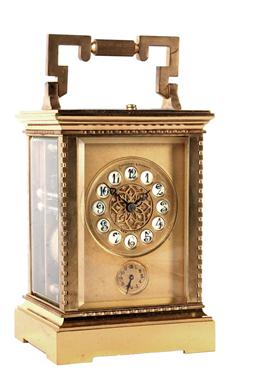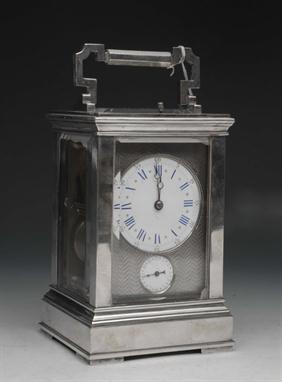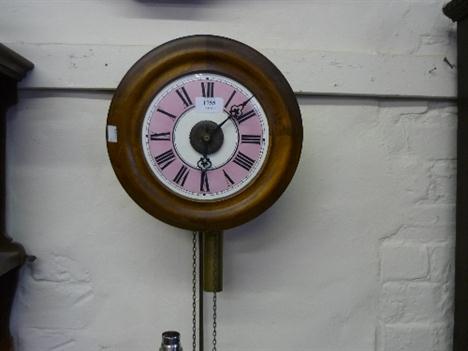A French gilt brass gorge cased petit sonnerie striking carriage clock with push-button repeat and alarm. Retailed by Elkington and Co., late 19th century. The eight-day two train movement striking the quarters on a graduated pair of gongs and sounding the hour and alarm on the larger of the two, the original platform lever escapement with GV monogram and numbered 118176 to table, the backplate numbered 64, with circular white enamel Roman numeral dial inscribed ELKINGTON & Co. to centre with Arabic five minutes to outer track, blued steel Breguet hands and set into a foliate scroll engraved gilt brass mask with subsidiary alarm setting dial to lower margin, the bevel glazed gorge case with hinged carrying handle, 14.5cm (5.75ins) high excluding handle; with original leather covered outer travelling case.
We found 14361 price guide item(s) matching your search
There are 14361 lots that match your search criteria. Subscribe now to get instant access to the full price guide service.
Click here to subscribe- List
- Grid
-
14361 item(s)/page
A gilt brass petit sonnerie striking carriage clock with push-button repeat and alarm. Unsigned, probably late 20th century. The eight-day two train movement striking the quarters on a graduated pair of gongs and sounding the hour and alarm on the larger of the two, with platform lever escapement and rectangular gilt dial with rosette centre within chapter ring applied with Arabic enamel cartouche numerals, bearing a retailer’s signature CAMERDEN & FORSTER, NEW YORK and with alarm setting dial to lower margin, the gilt bevel glazed case with hinged carrying handle above cavetto cornice and repeating block and bead decorated angles to uprights, on conforming skirt base incorporating squat bracket supports, 16.5cm (6.5ins) high excluding handle.
A French gilt brass gorge cased grande sonnerie striking carriage clock with push-button repeat and alarm. Unsigned, late 19th century. The eight-day two train movement striking the hours followed by the quarters on a pair of gongs every quarter of an hour, with original silvered platform lever escapement and numbered 3355 to backplate, the rectangular white enamel Roman numeral dial with Arabic five minutes, blued steel Breguet hands and subsidiary alarm setting dial to lower margin, the gilt bevel glazed gorge case with hinged carrying handle and Hours and quarters, Silent and Quarters only selection lever to underside, 15cm (6ins) high excluding handle; with original leather covered outer travelling case.
A decorative brass ‘wing‘ lantern clock. Bearing signature William Speakman, 20th century incorporating earlier elements. The posted countwheel bell striking movement with verge escapement mounted above the top plate and pendulum with anchor-shaped bob set within the frame of the clock between the trains, the dial with alarm disc, foliate scroll engraved decoration and bearing signature William Speakman, Hatton garden fecit in a curve to the upper margin of the dial centre within applied silvered Roman numeral chapter ring and with pierced steel hand, the composite frame with ball feet, slender baluster turned columnar uprights and tall urn finials flanking early pattern scroll pierced frets beneath bell housed within the domed bearer above, with brass side doors applied with glazed extensions surmounted with pierced frets, the rear with iron backplate fitted with an alarm mechanism, hanging hoop and spurs, 39cm (15.5ins) high.
An unusual padouk wood musical alarm table clock. Berguer London, probably early 19th century. The five pillar twin chain fusee movement with verge escapement and alarm playing a choice of two peels or a lively melodic tune on eight bells, the backplate engraved with an urn within a rococo scroll cartouche and decorative border incorporating leafy sprays to angles, with a 7 inch brass break-arch dial with alarm disc to the matted centre and blued steel hands within an applied silvered Roman numeral chapter ring with stylised fleur-de-lys half hour markers and Arabic five minutes to outer track and signed Berguer, London to lower edge the angles with female mask and scroll pattern spandrels beneath arch with CHIME/SILENT dial flanked by conforming scroll cast mounts, in a case with brass carrying handle to a moulded panel following the profile of the break-arch top with brass pineapple finials, the front door with ebonised fillet mouldings to the glazed aperture and brass inset angles, the sides with circular foliate scroll engraved brass sound frets above concave-topped windows, on moulded base with brass bracket feet, 39.5cm (15.5ins) high. Four makers with the surname Berguer (probably brothers) are recorded in Baillie, G.H. Watchmakers & Clockmakers of the World as working in London during the first quarter of the 19th century; Frederick 1805-24, John 1809-24, Francis (Holborn) 1820 and Joseph 1820. Two generations of makers with the same surname are also recorded working in Chaux-de-Fonds, Switzerland during the 18th century hence it is probable that the London-based makers at the start of the 19th century were first generation immigrants. The fact that the signature to the chapter ring suggests that the maker of the current lot was probably an immigrant may account for the unusual specification of the movement (which plays music as an alarm only) as well as the individual nature of the detail design of the case. These variations perhaps echo those seen on clocks made in London by an earlier generation of Huguenot immigrant makers working during the early years of the 18th century.
An extremely rare Charles II brass miniature lantern timepiece with original balance escapement and alarm. Unsigned, circa 1680. The posted movement with brass balance regulated crown wheel escapement and separate alarm mechanism fitted to the inside of the iron backplate sounding on a bell mounted within the domed bell bearer above, the frame with ball feet, column corner posts and vase turned finials, the dial with rosette decorated silvered alarm disc and original iron hand within engraved band of foliate tulip sprays incorporating monogram AM to upper margin, the applied silvered Roman numeral chapter ring with stylised wheatear half hour markers and quarter divisions to inner track, with dolphin pattern pierced frets, the rear with iron hoop and spurs for wall hanging (side doors lacking), 24.5cm (9.5ins) high. The current lot is extremely rare in that it still retains its original brass balance wheel escapement; although a small handful of full-size lantern clocks that retain their original balances are known, the cataloguer is not aware of another documented example of a miniature lantern clock surviving with its original balance wheel escapement intact. On close examination it can be seen that the dial engraving was originally laid out with the intention to leave a space for the signature of the maker within the upper margin of the centre, however, as it seems that the clock was to be supplied unsigned, the engraving was finished with the insertion of a flowerhead within this space. This inserted flowerhead incorporates the monogram AM (to the upper left lobe) which suggests the dial may have possibly been engraved by Abraham Martin who is recorded in Loomes, Brian The Early CLOCKMAKERS of Great Britain as an engraver from Geneva who was made a Free Brother of the Clockmakers’ Company in September 1682. Abraham Martin was a well-connected specialist workman who undertook work for Thomas Tompion (a watch dating to 1683 with case engraved by Martin resides at the Ashmolean Museum), he is also recorded receiving a gift of a month longcase clock from his friend, Richard Street, who was also known to have produced work for Tompion. It is perhaps interesting to further note that Tompion took in (through W. Dent) an apprentice named Jeremiah Martin in 1680. Fine quality movement details (notably the steel arbors incorporating delicate turned collets and the rare original steel wedges inserted into both the balance and alarm bottom potances) coupled with the fine engraving suggests that the current lot was made in the workshops of one of the leading London makers at this time; it is a shame that the decision was made to supply it unsigned. However the combination of these and other certain distinctive features, such as opposing steel and brass pulley cheeks and lugs riveted to the underside of the top plate for securing the movement bars, may assist to offer an attribution to a particular workshop with further research.
Concorde Memorabilia: a silver Carrs strut photograph frame, Sheffield 2003, 12 by 12cm, boxed, a Links of London plated model of Concorde on a rectangular base, boxed with certificate, and a Concorde travel alarm clock showing the times in London and New York, boxed with certificate to commemorate twenty seven years of commercial supersonic flight. (3)
RARE EARLY JAPANESE CLOCK - Japanese Lantern Clock or Kake-Dokei, Meiji Period, with iron top and bottom plates, engraved brass sides and face, brass bell, based on 18th c Dutch design, time and strike steel works with silk-suspended double arm crown escapement, fusee spring driven with alarm function, center steel disc rotates, carrying brass arm, outer ring indicates month, date indicated in upper right corner, hinged side panel, comes with fine lantern form wood and glass case on matching base, reticulated brass panels (one missing), clock is 5 1/2" (14.0 cm) tall, 3 1/8" (8.0 cm) square, case is 8" (20.3 cm) tall, 4 3/4" (12.1 cm) square, good as found condition, silk suspension missing.
1960`s `MAD MEN` ADVERTISING MERCHANDISE, A SUPERB 1960`s KNOLL DESIGN STAINLESS STEEL ASHTRAY, stamped for ` Marlboro` and used for Philip Morris Merchandising. A 1960`s NOVELTY PLASTIC `COCA COLA` SODA PULL TOP in the form of the original bottle shape, a Jack Daniels ALARM CLOCK, probably later, the dial depicting the famous logo, working order and with all paint work intact
A tinplate ‘Zeppelin’ alarm clock. Alloy bezel, printed card dial with seconds and alarm dials. 2 small printed Zeppelins in the centre, with ‘Zeppelin’. Alarm controls on top. With carrying handle and supporting feet. Basically GC (not working, some wear and rust, minute hand detached but present). Plate.3
A late Victorian brass carriage alarm clock the 1 3/4 inch enamel chapter ring of Arabic numerals over a subsidiary alarm dial within blind filigree work the case with fluted swing handle over filigree sides between half fluted corner pilasters on four short turned feet, the movement striking on a bell to the underside, (at fault) 15.5cm high
Henry Jacot, Paris a French gorge-cased carriage clock with the eight-day duration movement having a platform lever escapement and striking the hours and half-hours on a gong and with alarm, the front plate stamped with the secret trademark of Henry Jacot and numbered on the backplate ‘6838’, the white enamel dial with black Roman numerals and blued steel spade hands, the brass gorge case having a five ribbed handle, height 14.5cm (handle down).
A French brass alarm carriage clock, late 19th century, the shaped square case enclosing a Roman numeral dial with seperate hour display, carrying handle and repeat button to the top, bevelled glass panels, twin barrel movement with platform lever escapement, striking on a gong, height 19 cm.
A French gilt brass alarm carriage clock, late 19th century, the shaped rectangular case overall with engraved floral decoration, enclosing two circular Roman numeral dials with seperate hour display, carrying handle engraved and repeat button to the top, bevelled glass panels, twin barrel movement with platform lever escapement, striking on a gong, named to dial, height 19 cm.
Late Victorian repeating carriage clock with alarm, eight day movement striking hours and half hours on a gong, silvered engine-turned dial with subsidiary alarm dial, signed - 'Chas. Frodsham, France', in a rectangular gilded brass case with canted corners and angular swing handle, 16cm overall height to handle
-
14361 item(s)/page
























































